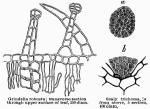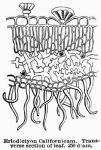BY THE EDITOR.
 Grindelia robusta, Nuttall.—The young parts of the cylindrical stem are covered with white, soft hairs. The leaves are thickish, sessile, more or less amplexicaul, spatulate-lanceolate dentate, and pellucid-punctate. The secondary nerves are sparingly branched, and at some distance from the margin form slings. The flower heads terminate the branches. The involucre consists of several rows of narrow spatulate, smooth, sharp-edged scales, which are curved back at the apex and are covered with a brown glutinous mass. The receptacle is somewhat convex; the florets are tubular, yellow and hermaphrodite.
Grindelia robusta, Nuttall.—The young parts of the cylindrical stem are covered with white, soft hairs. The leaves are thickish, sessile, more or less amplexicaul, spatulate-lanceolate dentate, and pellucid-punctate. The secondary nerves are sparingly branched, and at some distance from the margin form slings. The flower heads terminate the branches. The involucre consists of several rows of narrow spatulate, smooth, sharp-edged scales, which are curved back at the apex and are covered with a brown glutinous mass. The receptacle is somewhat convex; the florets are tubular, yellow and hermaphrodite.
The resinous covering of the leaves is secreted by the glandular hairs, which are always simple, frequently with a double row of cells, and occasionally parenchymatic; the terminal gland is four-to several-celled. Similar but pointed hairs are likewise observed. The mesophyll is a loose tissue with indistinct palissade layer, supported by thicker-walled cell-rows, which extend transversely through the leaf. The thin-walled cells contain much tannin.
Quite characteristic trichomes are found upon the involucral scales in depressions near the recurved apex, and consist of a mass of cells. without a stipe.—J. Moeller, in Phar. Centralhalle, 1883, No. 19.
Camellia oleifera, s. Cam. drupifera, Hooker.—Hugh McCallum obtained from the seeds, deprived of the husk, by means of ether, forty-four per cent. of a somewhat viscid yellowish oil, odorless and having an unpleasant aftertaste. In China it is known as cha yan, or tea oil, and is chiefly used as a hair dressing and as an illuminant. In addition to the oil, about 10 per cent. of a glucoside, giving all the reactions of saponin, was obtained from the seeds. Even then the marc, on being shaken with water, gave a persistent lather. This saponin is a friable, amorphous white powder, having only a slight creamy tinge, and a sweetish, afterwards, bitter, disagreeable and biting taste. Almost odorless when dry, it has a peculiar disagreeable odor when dissolved in water. The dust irritates the nostrils. It is insoluble in ether, sparingly soluble in absolute alcohol, freely in 84 per cent. alcohol, and very soluble in water, the latter solution having an acid reaction, and giving white precipitates with barium hydrate, basic lead acetate, and, on heating, with normal lead acetate. The solution emulsifies oils and chloroform, and, shaken with mercury, the latter is finely divided. It gives .9 per cent. of ash. Heated with hydrochloric acid, a flocculent, white precipitate (sapogenin) is thrown down, and a glucose remains in solution. The saponin was prepared by exhausting the seed, deprived of oil, with 84 per cent. alcohol, concentrating the tincture to a syrupy liquid, precipitating with absolute alcohol, redissolving in 84 per cent. alcohol, treating with animal charcoal and filtering.
The press cake left on expressing the oil, is called cha-tsai-peng, and its powder cha-tsai-fau. These are used for washing, for removing grease stains, for destroying worms, grubs, etc., and for poisoning fish, when kept in tanks.—Phar. Jour. and Tran., July 14, 1883.
The Fruit of the Brazilian Coffee Tree has been examined by Dr. Th. Peckolt, a portion of the investigation having been made and published in 1864.
| Weight of berry. | Pulp. | Mucilage and testa. | Coffee bean. | Ash of pulp. | |
| Fresh, | 1.780 | .658 | .282 | .840 gm. | 1.717 |
| Dried at 100°C., | .584 | .159 | .150 | .272 gm. | 27.750 |
| The fresh pulp contains, in 1,000 parts, | |||||
| Caffeine, | .270 | ||||
| Dark yellow, thick oil, | 5.000 | ||||
| Wax and red violet color, | 5.550 | ||||
| Soft resin, yellow, inodorous, tasteless, insoluble in alkalies, | 1.240 | ||||
| Resin, brown yellow, insoluble in ether, sparingly soluble in alkalies, | 15.900 | ||||
| Coffeotannin, not identical with that of coffee beans, | 14.620 | ||||
| Citric acid, tartrates, malates, trace of gallic acid, | 7.950 | ||||
| Glucose, | 67.400 | ||||
| Albuminous matter, | 11.100 | ||||
| Extractive matter, | 84.860 | ||||
| Pectin, mucilage, dextrin, salts, | 40.890 | ||||
| Water, | 759.800 | ||||
| Ash, | 17.170 | ||||
The ash is interesting for containing iodine, as shown by C. Weinhold, in 1865, who found 0.882 per cent. The author has met with it constantly, the percentage varying between .474 and .105, but in other parts of the tree it could not be detected. The ash of the pulp contains also large amounts of phosphoric acid, 9.987 per cent., ferric oxide, 11.38 per cent., and silica 15.162 per cent.—Zeitsch. Oest. Apoth. Ver., 1883, No. 22.
 Eriodictyon Californicum, Bentham.—The leaves are described by J. Moeller. They are leathery, lanceolate, about four inches (10 cm.) long, about half an inch (1 to 1.5 cm.) broad, short petiolate, repand-dentate, green and glossy above, dark reticulate and gray beneath. The upper epidermis is large-celled and covered with a moderately tough and delicately wavy-furrowed cuticle, the grooves containing many-celled glands upon two- or three-celled stipes. The secretion of the glands is yellowish green, resinous, soluble in alkalies, contains numerous needle-shaped crystals, and covers the upper surface sometimes to the thickness of .02 mm. Under the thick palissade layer is the mesophyll, composed of stellate cells, which, between the veins, are in contact with the small-celled epidermis of the lower surface; many of these epidermal cells are elongated to thin gray felt-like hairs. The primary nerves contain on the lower side a thick layer of collenchyma, and a palissade layer is formed in the angles of the secondary nerves. The epidermis alongside of the nerves is smooth, and contains only few glandular hairs like those of the upper surface. The parenchyma is free from tannin; many cells contain groups of oxalate crystals. Strong alcohol takes up 30 to 40 per cent. of resin, having a tolu-like odor. W. H. McLaughlin obtained two resins, one of which was soluble in ether, bitter principle, gum, tannin, fat, volatile oil, sugar, and another crystalline principle.—Phar. Centralhalle, 1883, No. 19.
Eriodictyon Californicum, Bentham.—The leaves are described by J. Moeller. They are leathery, lanceolate, about four inches (10 cm.) long, about half an inch (1 to 1.5 cm.) broad, short petiolate, repand-dentate, green and glossy above, dark reticulate and gray beneath. The upper epidermis is large-celled and covered with a moderately tough and delicately wavy-furrowed cuticle, the grooves containing many-celled glands upon two- or three-celled stipes. The secretion of the glands is yellowish green, resinous, soluble in alkalies, contains numerous needle-shaped crystals, and covers the upper surface sometimes to the thickness of .02 mm. Under the thick palissade layer is the mesophyll, composed of stellate cells, which, between the veins, are in contact with the small-celled epidermis of the lower surface; many of these epidermal cells are elongated to thin gray felt-like hairs. The primary nerves contain on the lower side a thick layer of collenchyma, and a palissade layer is formed in the angles of the secondary nerves. The epidermis alongside of the nerves is smooth, and contains only few glandular hairs like those of the upper surface. The parenchyma is free from tannin; many cells contain groups of oxalate crystals. Strong alcohol takes up 30 to 40 per cent. of resin, having a tolu-like odor. W. H. McLaughlin obtained two resins, one of which was soluble in ether, bitter principle, gum, tannin, fat, volatile oil, sugar, and another crystalline principle.—Phar. Centralhalle, 1883, No. 19.
Duboisia myoporoides, R. Brown.—J. Moeller made the following observations on the leaves; they resemble willow leaves in outline, attain a length of 12 cm. (44 inches), and width of 3 cm. (11 inch), are short petiolate, entire, the margin slightly revolute, and have a prominent midrib, the secondary veins diverging at nearly right angles and forming slings near the margin. A parenchymatic excrescence along the upper side, upon the midrib is characteristic for the leaves, and may be observed with the naked eye. The upper epidermis has few stomata and somewhat smaller, flatter, and more thick-walled cells than the lower epidermis, which contains numerous stomata and scattered clavate hairs. On placing a microscopic section in warm potassa solution, a large number of acicular crystals make their appearance upon the lower, but not upon the upper side of the leaf. The crystals are soluble in water and alcohol, and make their appearance after the leaf has been kept for several hours in water, but not after it has been extracted with alcohol.—Phar. Centralhalle, 1883, No. 20.
Tinctura Lappae fructus. (Read at the Pharmaceutical Meeting, October 16th.)—In No. 5 of the Ephemeris a letter by Dr. W. C. Reiter, of Pittsburg, was published, giving a detailed statement of his experience with the fruit (often called seeds) of Lappa major, and the manner of using it in psoriasis inveterata. Dr. Reiter prepared a tincture by macerating 1 lb. of the ground fresh fruit in 1 gallon of two years old whiskey, in a warm place, for two weeks; of the decanted or filtered tincture he gave from a teaspoonful to a tablespoonful. Much stress is laid on the menstruum to be used.
Having received a prescription for the tincture, to be used by a patient suffering for many years with the disease, I tried the whiskey; but the tincture was not a sightly preparation. After several experiments with menstruums of different strength I adopted the following formula:
| Ground burdock fruit | 16 | troyounces |
| Alcohol | 3 | pints |
| Water | 1 | pint |
Mix the liquids and percolate in the usual way until 4 pints of tincture are obtained.
The dose used is a teaspoonful 3 or 4 times a day. The remedy seems to be effective; after several months' use, the patient's hands and nails are assuming a normal condition.
Lancaster, Pa. CHAS. A. HEINITSH.
The American Journal of Pharmacy, Vol. 55, 1883, was edited by John M. Maisch.

